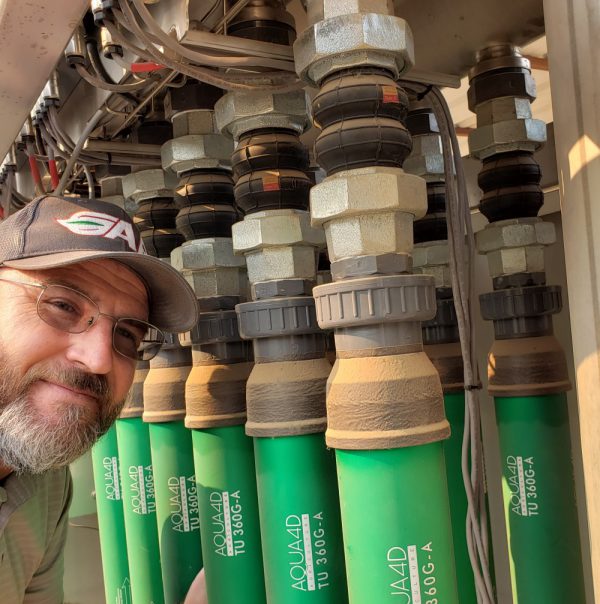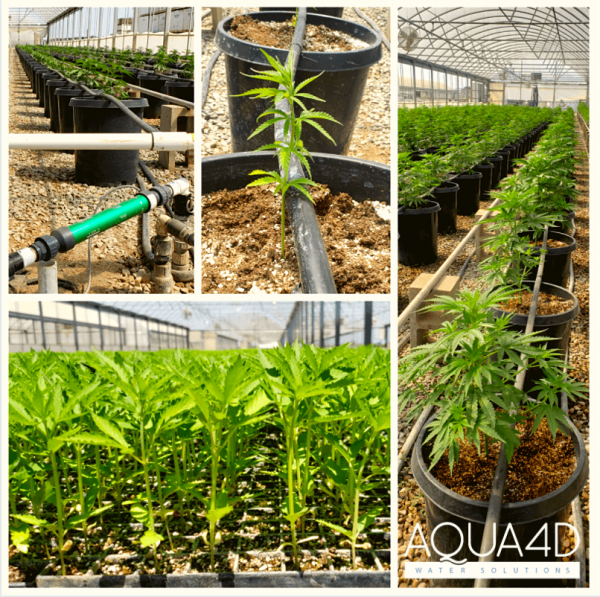It’s 6am local time when we start our video call, but Jeff Nunes is already sat out in his garden. We speak amid a backdrop of haze from the recent forest fires. It seems an appropriate setting for discussing water innovation in California – a state suffering from drought and the very real effects of climate change – and how new agricultural technology can bring about a greener future, here and around the world.
Jeff, you’ve been in this industry for decades: what sort of impact have you seen agtech making?
The positive impact of technology in agriculture is bringing a precise measurement of what’s needed when it’s needed, and being able to reduce our use of resources, water, fertilizers, and manpower. We’re now able to isolate diseases before they spread, to treat deficiencies before harvest, and increase our food production.
The biggest problem we have here in the Central Valley (California) is access to water. There’s also far too much toxicity in our soils, with some bad elements. So it’s about creating a remediating process, using plants and treated water is important – we’ve got to start cleaning things up before we get better.
Can agriculture rise to the challenge of these unprecedented times?
I think agriculture has a key role to play in a green recovery, especially using technologies like blockchain and data from drone flights. These are very important tools that we need to consider to help make the right calls at the right time, make changes, and create a safe atmosphere for workers, to help bring in a new era.
Some have been farming for generations, but have been borrowing from a bank they didn’t know they were going to owe to: the very soils they are growing on. That’s why I’m very fortunate to be working with AQUA4D, because water is the most important thing right now – we have to start with the essence of life.
AQUA4D is helping growers overcome huge challenges, such as salinity here in California. What sets this technology apart from other such solutions?
So far only reverse osmosis has been able to resolve salinity, with negative side effects like waste water and high energy consumption. AQUA4D is a solution without any of these side effects, being able to treat greenhouses as well as distances of up to 2.5 miles length in orchards. That’s a huge differentiation.
Can you give some examples of the impacts you’ve seen?
AQUA4D can alleviate several problems, especially if the water source is saline. For example, a kiwi project we currently have has started with sodium chloride at 800 parts per million in the water source. So we already have an issue with salts, and then the heavy fertilization process has led to more salt in the soil.
All we did was treat the kiwis with AQUA4D technology for 3 weeks. We saw the salts go down in the rhizosphere, and we were actually able to bring the trees back to life. We had new growth within 14 days; before we put the unit in all the leaves were burning, they were suffering, and within 14 days we were able to see new growth and healthy tissue! So AQUA4D can help with the remediation of what’s in the water before it gets to the plants.
(This video gives an insight into this process at work) :
What we need to understand is that our practices and water sources are very important. Especially with using AQUA4D, we need to enhance our practices in agriculture to use these tools correctly. A learning approach is really important, having them seeing what we do, and being open to change.
A big difference from the grower’s perspective is ROI – we show a Return on Investment in 1-2 seasons.
Where does this ROI come from?
Return on Investment happens from both more and less: less water, less fertilizer needs: water usage goes down because the soil stays moister for longer, and fertilizers are more efficiently dissolved. At the same time, we increase yields. We’re able to save time, resources and money which goes right into the farmer’s pocket.
With AQUA4D entailing less fertilizer use and less frequent irrigation, this also cuts back on labor too, so a saved earning comes from a decrease of spending – on fertilizers, water, and manpower. For me, this too is part of the dawn of a new agricultural era.
What crops can benefit from AQUA4D?
There are many varieties of crops which can benefit from AQUA4D. This includes our wine and grape industry. The increase in Brix that AQUA4D helps bring about is highly beneficial in the creating of sugars and grape maturity, thus increasing yields and the quality of fruits.
Around the world we also have new projects under way with avocados, citrus, berries, and here in California we have many projects where we’ve proven to increase yields in nut trees.
Can you give some examples of the impacts you’ve seen?
AQUA4D can alleviate several problems, especially if the water source is saline. For example, a kiwi project we currently have has started with sodium chloride at 800 parts per million in the water source. So we already have an issue with salts, and then the heavy fertilization process has led to more salt in the soil.
All we did was treat the kiwis with AQUA4D technology for 3 weeks. We saw the salts go down in the rhizosphere, and we were actually able to bring the trees back to life. We had new growth within 14 days; before we put the unit in all the leaves were burning, they were suffering, and within 14 days we were able to see new growth and healthy tissue!
So AQUA4D can help with the remediation of what’s in the water before it gets to the plants.
Here in the Central Valley, nuts are obviously an incredibly important crop – how has AQUA4D helped in pistachio and almond cases?
Almonds and pistachios are needy crops. Their water moisture level needs to be maintained; they do need plenty of water and proper nutrients. Being able to keep their rhizosphere moist is highly advantageous. With AQUA4D we see that water is assimilated faster and retention is improved.
AQUA4D helps keep the water in the rhizosphere, especially in clay and loamy soils. I’ve seen some major changes with crop acreage treated by AQUA4D with new growth. We started off with plants that are suffering, specifically in almonds and pistachios we see that this brings life back into the plants.
The trees that we started off with in the west Central Valley have very harsh conditions with drought and very bad water, and being able to actually treat this water showed an astronomical advantage. We’re seeing that as soon as we have growth, farmers are trying to maximize the units we give them to divert some of the treated water to neighboring fields.
How exactly does AQUA4D solve these long-standing salinity issues?
AQUA4D prevents salts from crystallizing and stopping sodium chloride from bonding. We’re able to move and make available these important elements. We’re able to break the crystallization process that usually happens – most of these soil types would normally repel water, but AQUA4D invites water to stay.
Does AQUA4D also have impacts in greenhouses?
In hemp production we have a greenhouse that has started with seedlings, and we’re able to compare the root mass and root development in a very short time. Right off the bat, we’re able to see that AQUA4D treated water has created more feeder roots than the non-treated, a difference of almost 90%. This meant we were able to make quicker seedlings ready for planting. We also predict that our plants will have a higher survival rate over the years.
Here in this Salinas project, AQUA4D has exponentially increased the root mass after 60 days. We see an increase in growth and biomass on the plant (indica variety). I’m intrigued also in what we can do with oil production – increasing not only flavors but also yields in weight.
I’ve done some experiments which have shown that AQUA4D has helped increase oil content in almonds and hemp. As growers get paid by weight, they’re interested in this from a financial point of view.
How optimistic are you that we can forge a greener future, post-pandemic?
The most essential thing we need to start with is our food – how we treat our food, what we’re putting in it. What we’re finding is what we put into our food is what we get out – pesticides, GMOs, herbicides: poison. These are all making their way into our foods and creating havoc in the human body.
So, it’s about creating a green way, a sustainable renewable way of dealing with fertilizers, water, and food.
We need to go to a microscopic level – the sources of our food: the soil, the nutrients, and I think that creating a sustainable agricultural setting can turn into a sustainable future for mankind.
What’s coming up for AQUA4D in California?
We have some great results coming out soon from a project in collaboration with University of California Extension Center (EC) here in Fresno. Our R&D is looking at nitrate usage and the ability to reduce fertilizers, and also HLB, a disease which has struck the citrus industry very hard. We’re able to create a healthy root mass and healthy soil, which stops HLB from setting into the citrus plants. And with an abundant root mass, we are enabling more absorption of fertilizers, meaning less needs to be used – less nitrate making it through the root zones and then into the water table.
Thanks for your time, Jeff!
– – –
Contact Jeff on LinkedIn: https://www.linkedin.com/in/jeff-nunes-51403249/
California
Water-Smart Agriculture
Precision Irrigation

Jeff and the AQUA4D system
Jeff surveys the impact of AQUA4D on almond trees




